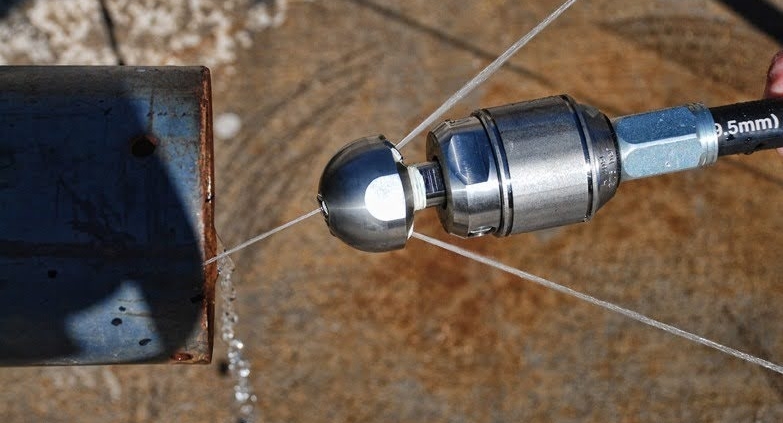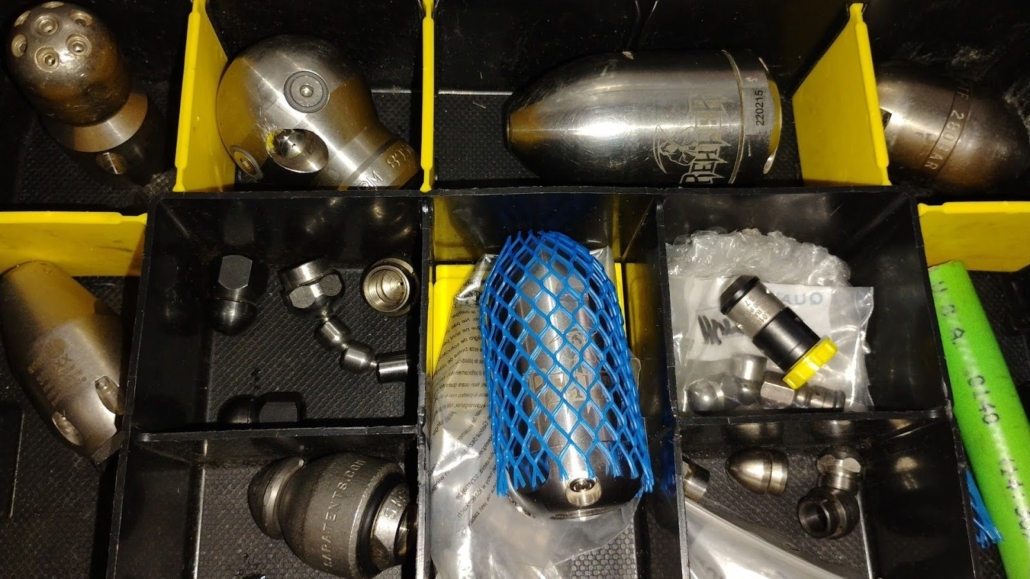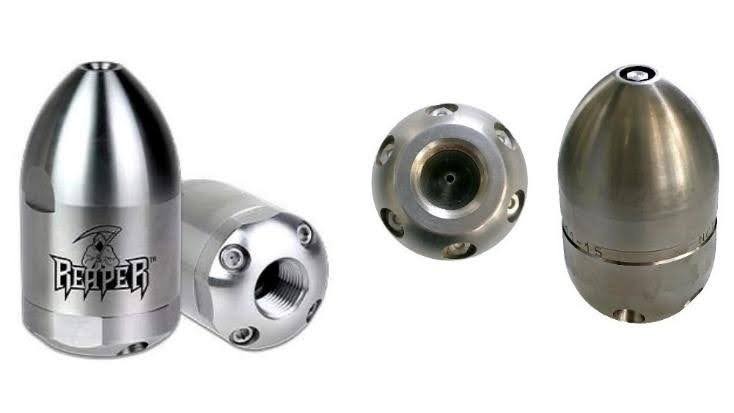The Jetting NOZZLE: The Most Impactful Component to a Hydro-Jetter’s Success
The Nozzle is the most impactful component on a hydro-jetter. A jetter without a nozzle would be like a great service-van with no wheels. Without a nozzle, the jetter’s GPM+PSI power couldn’t even approach the problem in the pipe, much less clear it! And, just as tire size and type can optimize a vehicle’s performance for different surfaces and purposes, the Nozzle is the most impactful component to optimize a hydro-jetter’s performance for various cleaning tasks and pipe-sizes.
Moreover, the reality is that the Nozzle has total control of the jetter’s actual GPM & PSI cleaning-power. How so? Four major nozzle-factors can make or break your jetter’s cleaning-power: Nozzle Design, Nozzle Calibration, Nozzle Maintenance, and Nozzle Wear & Tear.
Nozzle Designs & Types
The jetting-nozzle’s “spray-pattern” is what directs the water from the jetter toward the blockage and/or buildup to be cleared, which raises some “application questions”: Should the nozzle have a wide spray-pattern to scour the pipe-walls or a narrow pattern to impact blockages? Should it spray “fixed” streams of water, or should the streams be rotating? How much water should it spray forward vs. how much should it spray backward to thrust itself up the pipeline?
There are many different types of blockages and buildup in sewer and drain lines thus there are a great variety of nozzle-types and designs engineered to tackle the various cleaning-tasks to be encountered. What’s more is there are other pipeline-variables such as size, length, grade, number of turns, material, condition, jetting-access, etc. Very simply put, proper “nozzle-application” means “using the right tool for the job” – there is no “one size fits all” nozzle to handle every type of jetting-job at peak efficiency.
You don’t need to own every nozzle for every possible scenario, but it is wise to have the nozzle-types designed to go after the cleaning problems that you know you’ll encounter, making those jobs easier, more productive – and more profitable.
Nozzle Calibration & Optimization:
To optimize a jetter’s cleaning-efficiency, its nozzle’s orifices (spray-holes) must be correctly size-calibrated (drilled/bored) to match the jetter’s exact GPM (Gallons Per Minute) and PSI (Pressure) specifications and for the size and diameter of its jetting-hose. Be aware: just because a nozzle has the right thread-size to fit on the jetter’s hose-end doesn’t mean that the nozzle is a match! If the nozzle’s orifice-sizes haven’t been calibrated to the provide the correct release of water-flow (GPM) and correct pressure-buildup (PSI) at the end of that hose then the jetter will be like a runner trying to race in shoes that don’t fit – yes it the jetter still runs, but its performance will be significantly slowed down, losing effectiveness and competitiveness.
Like the runner, the jetter simply is not optimized for maximum performance. Bottom line:make sure that the nozzles you use have been calibrated to match your jetter’s specs for GPM, PSI, jetting-hose diameter, and jetting-hose length.
Nozzle Maintenance
Regular inspection is only half the battle, keeping each nozzle in top condition is just as important.
1. Clear plugged-up orifices immediately:
The nozzle’s orifice-holes will occasionally get plugged up, which is an immediate loss of performance. Think about it: if a nozzle has 5 orifices and one gets plugged then 20% of the potential cleaning-power has been nullified. If the nozzle only has 3 jets then 30% to 40% of the jetter’s cleaning power can be lost to a plugged orifice! It’s like an engine that is not running on all cylinders; it still runs but it’s significantly weaker and less efficient. An inexpensive orifice-cleaning tool is a must-have for the jetting pro to occasionally clear a plugged-up nozzle-orifice. Do a quick inspection of each orifice and clear them as needed – before and after jetting.
2. Prevent Surface-Rust and Hard-Water Buildup to Nozzle-Orifices:
All nozzle-orifices should be sprayed with a WD-40 type lube to help prevent surface-rust, hard-water buildup, and/or ice – at least on a weekly basis, if not every night. Even the high-end ceramic and carbide orifices of a “maintenance-free” nozzle can receive crippling buildup – so a quick shot of spray-lube to the orifices can be cheap insurance.
3. Does the Nozzle require Lubrication?
Most nozzles that have “rotating” water-jets will require some sort of lubrication. Many “rotators” just need their rotating parts sprayed with a light lube after each use (e.g. WD-40), but some premium nozzle-types require an injection of a specific lube-oil. A seized-up nozzle can be useless, so make sure you know and follow the correct lubrication procedures for all your nozzles – especially premium rotating nozzles designed for clearing tree-roots, grease, scale, etc.
Nozzle Wear & Tear:
A worn-out nozzle will adversely affect the jetter’s sewer/drain cleaning performance. Going back to the vehicle comparison, a worn-out nozzle is like bald tires on your vehicle, causing it to slow down or even “spin its wheels” when the going gets rough. Why? Because Nozzle-Orifices are subject to high-velocity erosion. Not only does water-erosion cause orifices to gradually get larger (reducing your jetter’s pressure), the worse effect is that eroded orifices also cause the water-jets to “sprawl” or “mist” rather than producing coherent and impactful “streams” of water.
This huge loss of cleaning efficiency can be a “blind” problem because we typically can’t clearly see the water-jets in action inside the pipe. However, if you inspect your nozzles daily and see grooves forming in the nozzle-body just beyond an orifice then that orifice is worn out – its water-jet is definitely “sprawling” thus physically impacting the nozzle-body, rather than rifling straight past the nozzle-body to fully impact the blockage or buildup to be cleared. Just like a clenched fist can hit harder than an open hand, the concentrated water-jet molecules from the un-eroded orifices of a newer nozzle—or better yet a nozzle with orifice-jets machined from more durable ceramic or carbide—will hit blockages and buildup harder and clear them faster, so throw away and replace worn out nozzles and/or orifices!
Choosing and Maintaining the Right Nozzles for Every Job
1. Take the time to maintain each nozzle. Keep each orifice of every nozzle clear and ready to create impactful water-jets for you. Lubricate rotating nozzles as needed. Spray nozzles down with WD-40 or the like to prevent surface-rust and hard-water buildup.
2. Jetting with worn-out orifices is like trying to cut with a dull saw-blade. The removable orifices in premium “cutting” nozzles should be replaced yearly (like replacing a worn saw-blade) if the nozzle is used on a regular basis. Basic “drilled” nozzles should be replaced often – if they look worn out, they probably are.
3. Before ordering new nozzles, know your jetter’s GPM and PSI specs as well as its jetting-hose size (diameter and length), then make sure your supplier is capable of calibrating nozzle(s) to match your jetter; if the supplier “generalizes”the sizing (“it works in that pressure range”) – or if they are are simply not tracking with your desire for maximum jetter performance – then look elsewhere for a vendor who knows how to calibrate your new nozzles for optimized GPM/PSI performance in the pipe.
4. Learn “nozzle application” to choose the right nozzle for each jetting task that you expect to encounter. Jetters typically include a few basic nozzles for blasting out simple soft clogs and debris, and their differences and applications should be listed in your jetter’s operating-manual. If those nozzles are slow to perform or simply can’t tackle the tougher jobs, consider adding “specialty” nozzles for premium jobs:
- “Reduced Rotation-Speed” nozzles such as the REAPER, WARTHOG, GREASE-HOG, & others are designed specifically for attacking/clearing tougher blockages like tree-roots, hardened grease, packed wipes, eggshell, etc. Also, Reduced Rotation-Speed nozzle types are often used for clearing heavier buildup that requires a more intense scouring of the pipe.
- KNUCKLEHEAD nozzles allow you to work through P-traps, floor drains, and tight bends in the pipe that other nozzles cannot get through.
- GRENADE nozzles are great for flushing out heavier debris from upstream runs.
- SUPER-SWEEPER nozzles enable your jetter to clear larger pipes and can actually dredge up the buildup of hardened silt and earth from the pipe floor.
- CHAIN-SCRAPING nozzles can de-scale the pipe walls and can provide a great “final prep” of a pipe before relining it, removing any leftover buildup or root “danglers” that your rotating nozzle left behind.
Where Performance Meets Experience
Nozzle-efficiency is clearly very important to the jetting professional. Whether you’re running a van-pack jetter, a trailer, a portable cart, or even a small hand-carry unit, if that jetter does not clear the line in a timely and competitive manner you’ll lose work hours, possibly fail to get the job done, and maybe even lose the customer! Having the right selection of nozzles that are optimized specifically for each of your jetters can make all the difference to your bottom line – and your sanity!
Visit our video-site youtube.com/@JETTERSnorthwest for lots of nozzle-demos, tips, and training. You can also ask questions in the video-comments, or feel free to give us a call at 877-901-1936. Also check out shop.jettersnorthwest.com for specific nozzles, hoses, jetting accessories, and more information.
JETTERS NORTHWEST is a 20+ year-old product line of Seattle Pump & Equipment Co. – a service and sales center for jetters for over 50 years.





